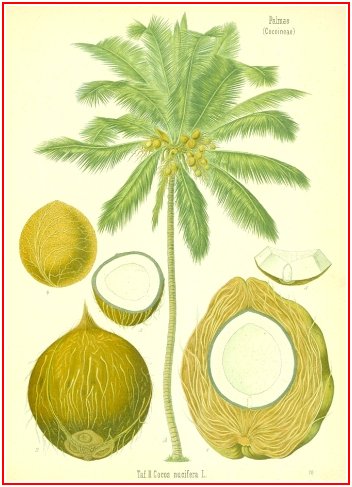
|
|

Coconut Oil Martindale�s 24
thCoconut Oil (B.P.C. 1949).
Ol. Cocois; Coconut Butter; Oleum Cocos Raffinatum; Oleum Cocosis; Aceite dc coco.Foreign Pharmacopoeias: In Chil., Dan., Fr., Ind., and Jap.
A solid white or pearl-white fat with an odour of coconut and a bland taste, obtained by expression from the kernels of the coconut, the fruit of Cocos nucifera (Palmae). It becomes rancid on exposure to air. Store in a cool place..
Soluble 1 in 2 of alcohol (at 60˚) very soluble in ether, chloroform, and carbon disulphide. M.p. 20˚ to 26˚
Uses. It forms a readily absorbable ointment basis. It is used commercially in the preparation of `marine' or sea-water soaps, as coconut-oil soaps are not easily precipitated by sodium chloride.
Liq. Sap. Ol. Cocois (B.P.C. 1934) Solution of Coconut Oil Soap. Prepared from coconut oil 183.1 g., potassium hydroxide 19�7 g., sodium hydroxide 19�7 g., water to 1000 ml. and saturated with thymol. Used as a shampoo and skin cleanser.
Sapo Liquidus (Fr, P.) Savon Liquide. Coconut-oil soap 360 g, and water to 1000 g. To be diluted with 5 parts of water for surgical use.
Sapo Olei Cocosis (Fr. P.). Coconut-oil Soap; Savon Mou d'Huile de Coco. Prepared from coconut oil with potassium hydroxide and water.
Coconut Oil. USD 1926 Part II
Oil of Coconut. Coconut Oil. Cocoanut Butter. Oleum Cocos, P. G. Oleum Cocois. Beurre de Coco, Fr. Kokosnuss�l G.
This must not be confounded with the fixed oil of the chocolate nut, which is often called cocoa, butter (See Oleum. Theobromatis.) The substance here considered is the fixed oil of the coconut, which is the seed of the coconut palm, Cocos nucifera L., universally known as the coconut tree, or cocoanut tree.
The oil is obtained either by expression or decoction, often by insolation, i.e., exposing the rasped nuts to the heat of the tropical sun. It is of a fine white color, of the consistence of lard at ordinary temperatures, becoming solid, like suet, between 4.4˚C. and 10� C'., and liquid at about 26.7˚C., of a bland taste, and a peculiar, not disagreeable odor.
It is readily dissolved by alcohol. It contains large quantities of the glycerides of myristic and lauric acids, with smaller quantities of the glycerides of palmitic and oleic acids.
It has also been found to contain several volatile acids, as caproic, caprylic, and capric acids. (Lewkowitsch, Chemical Analyses of Oils, Fats, and Waxes, 2d edition, 1398, 538.)
The oil has been used for various purposes in medicine and pharmacy. It has been employed as a substitute for cod liver oil-especially in the form of a proprietary preparation, coco-olein, a most unfortunate substitution as it contains neither the vitamines nor the peculiar fatty acids to which cod-liver oil owes its unique value.
In Germany it has been used in pharmacy, to a considerable extent, as a substitute for lard, to which, according to Pettenkofer, it is preferable on account of its lesser tendency to rancidity, its more ready absorption when rubbed on the surface of the body, and its lesser liability to produce chemical changes in the substances with which it is associated. Besides, it takes up one-third more water, which is a useful quality when it is desirable to apply saline solutions externally.
To prepare it for use, nothing more is ordinarily necessary than to melt it at a moderate heat, and strain it through linen. If colored, it may he digested with powdered animal charcoal, and subsequently filtered through paper. ( A. J. P., xxix, 331.)
When chilled and pressed, a solid residue, which is coco-stearin, is obtained. This is extensively used as a substitute and adulterant of the genuine cocoa butter in the confectionery trade.
Coconut oil is employed in the manufacture of soap, particularly of the transparent varieties, and the so-called "marine soaps" and filled soaps; it is also largely used for giving firmness and lathering qualities to the ordinary soap; this property also permits of the addition of a large quantity of water to the soap.
Unfortunately, coconut oil soap is very apt to contain free caprylic acid; the persistent rancid odor, resembling that of infants vomit, left upon the skin after washing with its soap is an effectual bar to its very extended use.
Besides the oil itself, the dried pulp of the coconut is sent to European and American markets in largo amounts under the name of copra.
According to Parisi, the endocarp or meat of the coconut is a powerful tenicide. The patient should drink the milk and then eat the flesh of the nut. The coconut is said to be largely used in India as a vermifuge and the matter appears to have practical importance.
Powdered coconut shells were at one time largely used in America as an adulterant for spices. Their debris is readily recognized under the microscope by the peculiar elongated stone cells which have brownish-yellow walls and dark-brown contents.
Library
![]()